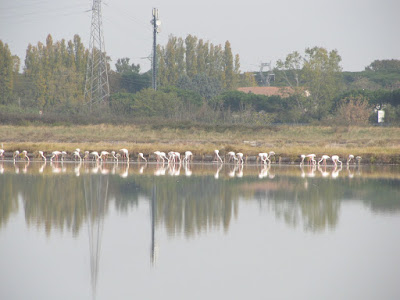I have been away from this for a long time. I am newly motivated because a couple of people viewed my blog. I traveled to Japan with OAT over the summer, and just finished making a slide show of my trip, so there is no good reason I can think of not to post the birds I saw there. So, here they are:
This picture was taken at Kenrokuen Gardens on a hot day in July as we walked over bridges and around ponds.
Heron at Sanjusangendo Temple captured by my camera a few days later.
This heron was waiting to say good-bye as we parted on a ferry from Ikuchijima Island.
Here is some information on herons:
The
grey heron (
Ardea cinerea) is a long-legged
predatory wading
bird of the
heron family, Ardeidae, native throughout temperate
Europe and
Asia and also parts of
Africa. It is resident in much of its range, but some populations from the more northern parts
migrate
southwards in autumn. A bird of wetland areas, it can be seen around
lakes, rivers, ponds, marshes and on the sea coast. It feeds mostly on
aquatic creatures which it catches after standing stationary beside or
in the water or stalking its prey through the shallows.The birds breed
colonially
in spring in "heronries", usually building their nests high in trees. A
clutch of usually three to five bluish-green eggs is laid. Both birds
incubate the eggs for a period of about 25 days, and then both feed the
chicks, which fledge when seven or eight weeks old. Many juveniles do
not survive their first winter, but if they do, they can expect to live
for about five years.(This formation came from Wikipedia)
This picture of two cormorants I took along the Katsura River as we got ready to take a boat up the river and a hike up a mountain to visit the Zen monk Obayashi san for macha tea ceremony.
The
Japanese cormorant, also known as Temminck's cormorant, is a cormorant
native to East Asia. It lives from Taiwan north through Korea and Japan
to the Russian Far East.
Wikipedia
What is a Cormorant or a Darter?
Pity the poor cormorant. There’s scarcely a bird in the world
as unfairly maligned, deemed the world over as a bad seed due to its
ungainly proportions and reportedly insatiable appetite for bait fish.
But this awkward family is of an ancient lineage, one of the oldest of
all the birds and with similar ancestors reaching all the way back to
the dinosaurs. The form is a classic one – long-billed, web-footed, and
waterborne – and shared in some sense with the order of birds the
cormorants, and their sister taxa the darters, lie within,
the newly resurrected Suliformes.
That group consists of the two families treated here, along with the
boobies, frigatebirds, and tropicbirds, all highly aerial marine
species. The comparatively aquatic and frequently freshwater cormorants
and darters are outliers, both in habitat preferences and panache, but
we’re all about the underdogs here. Let’s take the two families
together, and then separately.
Both cormorant and darters are superb swimmers, specializing in
pursuing fish underwater before returning to the surface where they sit,
characteristically quite low in the water, and swallow them
head-first. Both families use their feet for propulsion, and as such
those appendages are uniquely webbed across all four toes, effectively
broadening the surface area they use to propel themselves. It’s a trait
they share with the other Sulids, as well as the pelicans.
Cormorants and darters are long-bodied and that, paired with feet at the
far end of their bodies, makes them awkward when out of the water.
Though powerful flyers,
they’re rather ungainly when
taking off from the surface,
but it’s on land that we see that most famous of cormorant behaviors.
Sitting atop a cliff face or piece of flotsam following a fishing
outing, they’ll spread their wings wide to dry. It’s suggested that
this is because they lack the oils found in other birds to waterproof
their feathers, but that’s not true. Waterproofing is an innate
characteristic of feathers due to their physical structure. No extra
oil is required. But both cormorants and, in particular, darters are
unique in having feathers that are
less naturally
water-resistant than other birds, an adaptation that enables them to
forage underwater more easily. However, this necessitates regular time
out of the water to
dry sodden feathers and regulate body temperature; the time spent in that classic crucificial position.






























